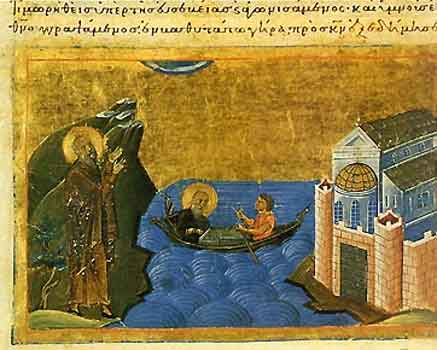|
|
11th-century Byzantine miniature representing Studion Monastery Studion (Latin: Studium) was historically the most important monastery of Constantinople, the capital of the Eastern Roman Empire. Although the monastery has been derelict for half a millennium, the laws and customs of the Studion were taken as models by the monks of Mount Athos and of many other monasteries of the Orthodox world; even today they have influence. The ruins of the monastery are situated not far from the Propontis in the section of the city called Psamathia. It was founded in 462 or 463 by the consul Studios (Latin: Studius), a Roman patrician who had settled in Constantinople, and was dedicated to St. John the Baptist. Its first monks came from the monastery of Acoemetae. The Studites gave the first proof of their devotion to the faith during the schism of Acacius (484-519); they also remained loyal during the storms of Iconoclastic dispute in the eighth and ninth centuries. They were driven from the monastery of Studion and the city by Emperor Constantine Copronymus; after his death (775), however, some of them returned. Abbot Sabbas zealously defended the Orthodox doctrines against the Iconoclasts at the Seventh Ecumenical Council in Nicaea (787). His successor was St. Theodore of Studion to whom the monastery owes the most of its fame, and who especially fostered study. During St. Theodore's administration also the monks were harassed and driven away several times, some of them being put to death. Theodore's pupil Naucratius re-established discipline after the Iconoclastic dispute had come to an end. Abbot Nicholas (848-5 and 855-58) refused to recognize the Patriarch Photius and was on this account imprisoned in the Studion. He was succeeded by five abbots who recognized the patriarch. The brilliant period of the Studion came to an end at this time. In the middle of the eleventh century, during the administration of Abbot Simeon, a monk named Nicetas Pectoratus (Stethatos) made a violent attack on the Latins in a book which he wrote on unleavened bread, the Sabbath, and the marriage of priests. In 1054 he was obliged to recant in the presence of the emperor and of the papal legates and to throw his book into the fire, but he began the dispute again later.
St Theodore the Studite (from 11th-century mosaic), Nea Moni, Chios.
As regards the intellectual life of the monastery in other directions it is especially celebrated for its famous school of calligraphy which was established by St. Theodore. The art of manuscript illuminations was cultivated, with many brilliant products of the monastic scriptorium now residing in Venice, Vatican City, and Moscow (e.g., Chludov Psalter). In the eighth and eleventh centuries the monastery was the centre of Byzantine religious poetry; a number of the hymns are still used in the Greek Church. Besides St. Theodore and Nicetas, a number of other theological writers are known. Three of the Studite monks rose to become the ecumenical patriarchs; and three emperors - Michael V, Michael VII, and Isaac I Comnenus - took monastic vows in the Studion shortly before ending their lives there. In 1204 the monastery was destroyed by the Crusaders and was not fully restored until 1290. The Russian pilgrims Anthony (c. 1200) and Stephen (c. 1350) were amazed by the size of the monastic grounds. It is thought that the cloister sheltered as much as 700 monks at the time. The greater part of the monastery was again destroyed when the Turks captured Constantinople in 1453. The only part to survive into the 20th century was the Cathedral of St. John Baptist, probably the oldest remaining church in Istanbul, a 5th-century basilica which was converted by Bayezid II's equerry into the mosque Imrachor-Dschamissi (literally, "a mosque of the stablemaster"). The ancient structure sustained grave damage from the great fires of 1782 and 1920; the earthquake of 1894 also contributed to its ruin. Following the earthquake, a group of Russian Byzantist scholars, led by Fyodor Uspensky, opened the Russian Archaeological Institute on the monastery grounds, but its activity was suppressed in the wake of the Russian Revolution of 1917. During the subsequent decades, the ruins of the monastery complex were looted by local inhabitants to repair their houses, while the magnificent 13th-century pavement still lies open to elements "and disappears slowly but steadily".[1]
References This article incorporates text from the public domain Catholic Encyclopedia. Official website of the Ecumenical Patriarch Retrieved from "http://en.wikipedia.org "
 |
|
|||||||||||||||||

